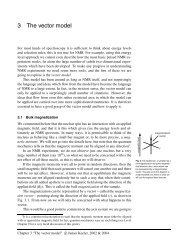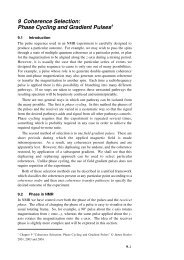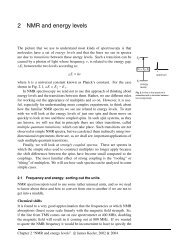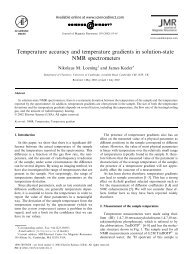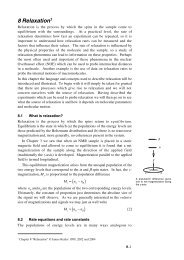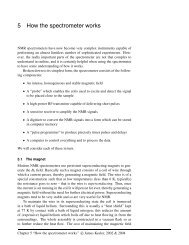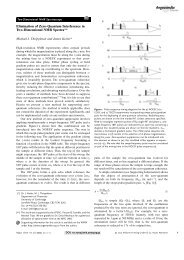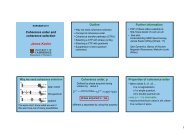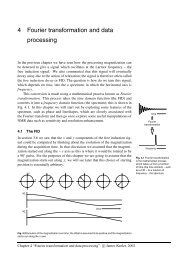Chapter 6: Product operators - The James Keeler Group
Chapter 6: Product operators - The James Keeler Group
Chapter 6: Product operators - The James Keeler Group
- No tags were found...
You also want an ePaper? Increase the reach of your titles
YUMPU automatically turns print PDFs into web optimized ePapers that Google loves.
6.5 Multiple quantum terms6.5.1 Coherence orderIn NMR the directly observable quantity is the transverse magnetization, whichin product <strong>operators</strong> is represented by terms such as I 1xand 2I 1zI 2 y. Such termsare examples of single quantum coherences, or more generally coherences withorder, p = ±1. Other product <strong>operators</strong> can also be classified according tocoherence order e.g. 2I 1zI 2 zhas p = 0 and 2I 1xI 2yhas both p = 0 (zero-quantumcoherence) and ±2 (double quantum coherence). Only single quantumcoherences are observable.In heteronuclear systems it is sometimes useful to classify <strong>operators</strong>according to their coherence orders with respect to each spin. So, for example,2I 1zI 2 yhas p = 0 for spin 1 and p = ±1 for spin 2.6.5.2 Raising and lowering <strong>operators</strong><strong>The</strong> classification of <strong>operators</strong> according to coherence order is best carried outbe re-expressing the Cartesian <strong>operators</strong> I xand I yin terms of the raising andlowering <strong>operators</strong>, I +and I –, respectively. <strong>The</strong>se are defined as followsI = I + iI I = I − iI[6.6]+ x y − x ywhere i is the square root of –1. I +has coherence order +1 and I –has coherenceorder –1; coherence order is a signed quantity.Using the definitions of Eqn. [6.6] I xand I ycan be expressed in terms of theraising and lowering <strong>operators</strong>( ) = ( )11Ix = 2 I+ + I− Iy 2 i I+ – I−[6.7]from which it is seen that I xand I yare both mixtures of coherences with p = +1and –1.<strong>The</strong> operator product 2I 1xI 2xcan be expressed in terms of the raising andlowering <strong>operators</strong> in the following way (note that separate <strong>operators</strong> are usedfor each spin: I 1±and I 2±)112I1 I = 22 × ( 2 I + 1I )× ( 1 2 I + 2I )x x + − + 2−[6.8]11= 2 ( I1 +I2+ + I1 −I2− )+ 2 ( I1 +I2− + I1 −I2+)<strong>The</strong> first term on the right of Eqn. [6.8] has p = (+1+1) = 2 and the second termhas p = (–1–1) = –2; both are double quantum coherences. <strong>The</strong> third and fourthterms both have p = (+1–1) = 0 and are zero quantum coherences. <strong>The</strong> value ofp can be found simply by noting the number of raising and lowering <strong>operators</strong>in the product.<strong>The</strong> pure double quantum part of 2I 1 xI 2xis, from Eqn. [6.8],1double quantum part[ 2I 1 xI 2 x]= 2 ( I 1 +I 2 ++ I 1 −I2 − ) [6.9]<strong>The</strong> raising and lowering <strong>operators</strong> on the right of Eqn. [6.9] can be reexpressedin terms of the Cartesian <strong>operators</strong>:6–12



